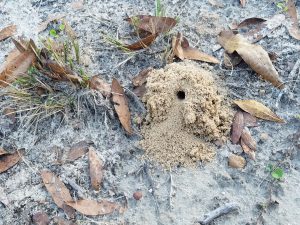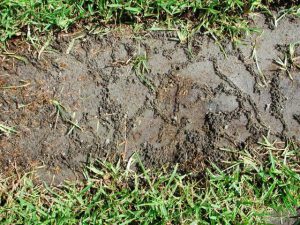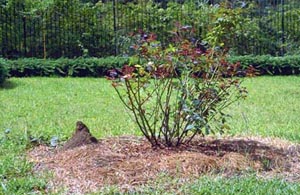Lawns and landscapes are greening up this time of year, and it’s not just plants showing signs of activity. All sorts of creatures are out there living their lives, and some of them are doing some digging.
From little piles of dirt to big mounds and long tunnels, it can be frustrating to figure out what is disrupting your carefully tended lawn or ornamental bed. Luckily, there are differences between the possible culprits. Here are some of the possibilities (see the associated links for more information and control methods):
-
Miner Bees (and other ground nesting bees and insects) – Miner bees are harmless, solitary bees that tunnel into the soil. Not to be mistaken for yellowjackets, each bee digs her own small nest to lay her eggs in. Multiple such bees may be attracted to the same location, but they do not form hives and aren’t aggressive. Small mounds of soil may form around the entrances to their nests, but these will vanish after a rain.
-
Mole crickets – These are crickets that dig small tunnels just under the surface of the soil. Several species live in Florida, one of which is native and is not a pest. Non-native species can become pests of turfgrass.
- Moles – Small mammals (not rodents) that produce raised tunnels along the surface of the ground. They forage for insects among the roots of plants, and while their presence does have some benefits, many homeowners dislike their aesthetic contributions to the landscape. If you can overlook their tunnels, they do help aerate soil and eat pests like mole crickets, grubs, ant larvae, caterpillars, and slugs.
- Pocket Gophers – Sometimes called “sandymounders” or “salamanders” by old-timers, these are small rodents that dig tunnels beneath the ground. Active especially in cooler months, they make a series of mounds of soil in a line along their tunnel as they excavate. They feed on roots, bulbs, and tubers, though their sand-mounding is often more a problem than their feeding.
-
Fire Ants – A single ant isn’t particularly threatening, but fire ants have found that thousands of rage-filled friends make a good deterrent. They build large mounds of soil to help regulate temperature and moisture in their nests, which can be quite unsightly in the landscape. Disturbing these mounds will unleash hordes of stinging ants, so beware; while they don’t necessarily do any harm to plants, they aren’t terribly friendly neighbors.
- Squirrels -These tree-dwelling rodents may nest up in the boughs, but often come down to the ground to look for food. In doing so, they may dig small holes as they forage for nuts, seeds, and fungi. The holes they dig are typically shallow and usually not too much of a problem.
- Armadillos – Nocturnal and heavily armored, the armadillo forages for insects in the ground. While it may sound beneficial to have an animal removing all the pest insects around, they aren’t careful about the damage they do while they feed. A hungry armadillo can dig numerous 3-5 inch wide, 1-3 inch deep holes in a lawn overnight, and may also burrow under structures, driveways, and patios.
- Yellowjackets – Yellowjackets are a bit of an honorable mention for this list, due to the fact that their digging often goes unseen. These ground-dwelling hornets leave no mounds or raised tunnels to identify their nests by. Instead, a small hole is often the only indication they are present, until a person or pet disturbs them. Then…surprise! It’s time for stinging, screaming, and crying.
For animal pests, the Florida Fish and Wildlife Conservation Commission maintains a list of nuisance wildlife trappers at https://public.myfwc.com/HGM/NWT/NWTSearch.aspx. For insects, you may need to contact a local pest control specialist or company. For help in identifying a problem, contact your local Extension office.
- The Eastern Lubber Grasshopper - June 5, 2025
- Grass is Growing; Time for Mowing - April 30, 2025
- Variegation, Viruses, and You - June 27, 2024



